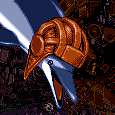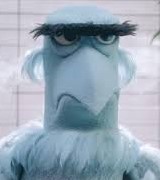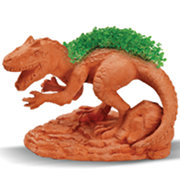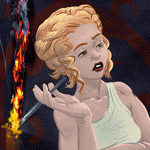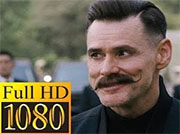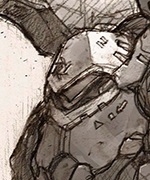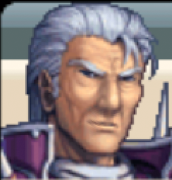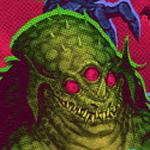|
  The year is 1910. The American Wild West is becoming more and more tame. The famous lawmen and outlaws that rode through the savage frontier alike have come and gone, and an old man walks into a bar in Abilene, Kansas claiming to be Silas Greaves (a famous bounty hunter from years a go). A young man named Dwight offers the drifter a beer and coaxes him into tales of his adventures. Silas says he has met just about every famous gun in the West, and his stories are so far-fetched that they can't possibly be true... can they?  The Call of Juarez series are Western themed first person shooters created by Techland and published by Ubisoft. They have never really been critical darlings with most of them only netting mid to positive scores. However the first two games in the series (Call of Juarez and Call of Juarez: Bound in Blood) were both praised for their excellent recreation of the Wild West. The original Call of Juarez put Techland on the map and its sequel 2009 Bound in Blood went on to selling quite well. Then the series hit a serious slump. 2011's Call of Juarez: The Cartel was critically panned. Poor design, mixed with bad (and often hateful) writing, and to top it all off it was set in modern day, almost completely eliminating the fun Western setting Techland had made. In a 2015 interview with Eurogamer, CEO of Techland even referred to The Cartel shipping the way it was as a “mistake”. It was hard to imagine that series would ever come back after such a low, but in 2013 they came back hard. Call of Juarez: Gunslinger is an fun and fast paced return to the series's roots. Taking inspiration from movie serials, dime novels, and spaghetti westerns, Gunslinger reintroduces us to every famous outlaw to ever sling a gun and has us hunt them down as the fictional Silas Greaves (a character based off several real life individuals such as Frank "Pistol Pete" Eaton). With it's unique artstyle, unique use of unreliable narration, and arcade style gameplay, Gunslinger has done pretty well for a budget game of it's size and scope. 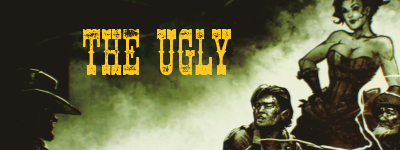 My name's TheJayOfSpade,  (artwork by HelloWinter) (artwork by HelloWinter)the rootin' tootin'-est buckaroo this side of the Mississippi. I'll be playing through the game on normal and collecting all the Nuggets of Truth. I plan to have some special bonus videos, so stay tuned! Please no gameplay or story spoilers, but if you want to talk about other Western themed games, that's totally okay! Just be kind and if you have a late game story spoiler for something like Red Dead Redemption, just put that in Spoiler Text. 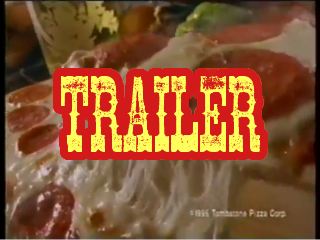 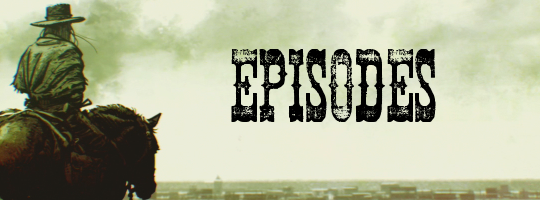  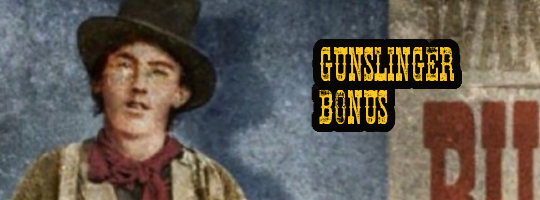 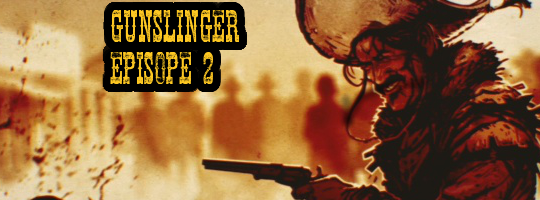  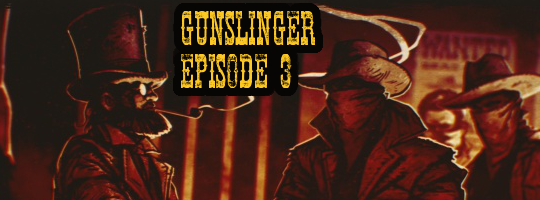  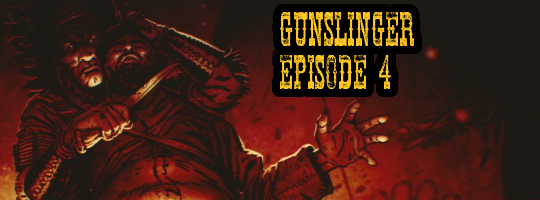  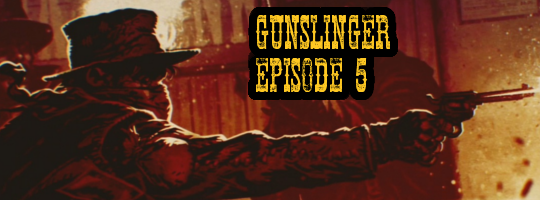  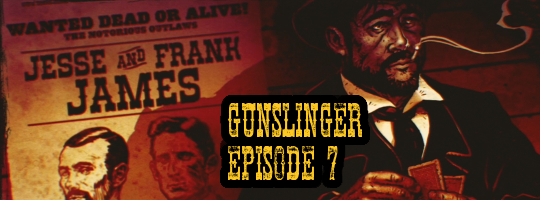  
TheJayOfSpade fucked around with this message at 22:45 on Oct 26, 2016 |
|
|
|

|
| # ? Apr 26, 2024 01:01 |
|
 Here are all the Nuggets of Truth that we collected in the video, they're a pretty interesting read and some of them mention character we'll met a little bit later in the game. 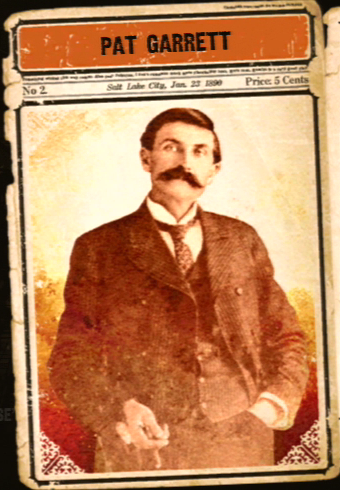 Pat Garrett Patrick Floyd “Pat” Garrett was born on June 5, 1850 in Cusetta, Alabama and grew up on a prosperous Louisiana plantation located just below the Arkansas state line. He died on January 29, 1908, hot in uncertain circumstances on the road from Las Cruces, NM, by one Jesse Wayne Brazel. Pat was a cowboy, a buffalo hunter, a bartender, and a customs agent, but history remembers him as the sherrif who killed Billy the Kid. Garrett and Bonney met in a saloon and for a while they fellow card players. When Garrett was made Sheriff of Lincoln County and Governor Wallace put a 500-dollar bounty on the Kid's head, the newly minted lawman began a relentless pursuit. Despite numerous traps, Billy was able to escape the tightening noose. He could not run forever, though. On July 4, 1881, in Fort Sumner, Billy, most likely unarmed, entered a room where Pat Garrett was lying in wait, sitting in the darkness. Billy asked the question “¿ quién es...?” (Who's there?) And Garrett answered with two shots from his revolver. One hit Billy in the heart, killing him on the spot. He was buried in the Fort Sumner cemetery, between the graves of two friends: Tom O'Folliard and Charlie Bowdre. Many people later accused Garrett of killing the Kid in a dishonorable manner. The book he co-authored, “The Authentic Life of Billy the Kid,” in which Billy was portrayed as a degenerate murderer, did nothing to lift that disreputable cloud. That image of the Kid, however, became part of his legend and remains so to this day. 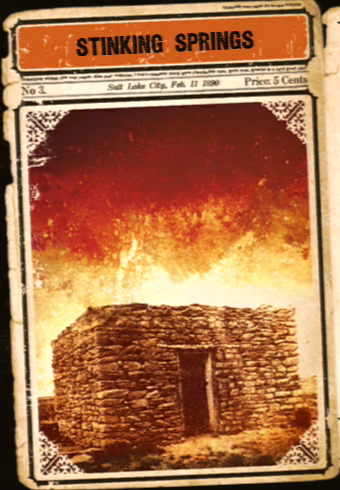 Stinking Springs Pat Garrett was relentless in his pursuit of Billy the Kid and his gang. Garrett and his posse tracked them to a deserted stone farmhouse in Stinking Springs and surrounded the building. Keeping Bill company was a colorful collection of desperados. Among them were Tom Picket, Billy Wilson, Charlie Bowdre, and “Dirty Dave” Rudabaugh. Rudabaugh crossed paths with such legends as Dave Mather, Bat Masterson, Wyatt Earp, and Doc Holiday and died in a rather unsavory manner, as he was shot then decapitated by a Mexican machete in 1886. Charlie Bowdre (who probably killed Buckshot Roberts in the Blazer's Mill Gunfight) did no survive the siege at Stinking Springs as a bullet hit him in the chest while he was passing a window. The others surrendered on the following day, December 23, 1880, after Dirty Dave hoisted a white flag. The captured criminals were transported to Santa Fe while Billy was taken to Mesilla where he was sentenced to death by hanging. He was then moved to Lincoln, NM to await execution. It never happened, however, as the Kid pulled off a spectacular jailbreak.  Lincoln County War The Lincoln County War is often considered one of the most famous examples of a “range war” in the history of the west. Range wars were conflicts over the control of “open range” or rangeland freely used for cattle grazing. The disputes were usually over grazing or watering rights, but in this case, the fight was over the control of the dry goods trade in Lincoln County. The quarrel arose around a conflict of interests between the Dolan-Murphy faction and a newly arrived Englishman, John Tunstall. At first, they tried to use the legal system to resolve their dispute, but soon the fight devolved into a conflict between armed gangs. Murphy and Dolan had ties to outlaws like John Kinney and his gang and Jesse Evans, whose outfit was known as The Boys. They were responsible for the death of Tunstall, which became the central catalyst of the conflict. The other side had The Regulators. William Bonney (a.k.a. Billy the Kid) rode with them, promising revenge on the men who murdered Tunstall. Both sides were sworn in by different offices of the law so technically they were all acting within the law. After The Regulators were defeated, some of their members became fugitives and, just like Billy the Kid, met untimely and violent ends. 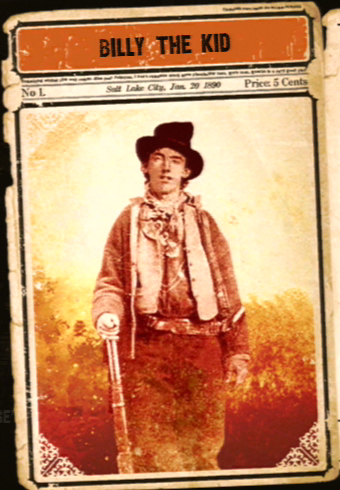 Billy the Kid Willian Henry McCarty, also known as William H. Bonney, Kid Antrim, or Billy the Kid, was probably born between 1859 and 1861. He died on July 14, 1881, shot by the sheriff Pat Garrett in Fort Sumner, NM. To this day, he remains one of the Wild West's most recognizable outlaws. Billy stood approximately 5'8” tall and was of slender build, with blue eyes, blonde hair, and a boyish charm. Many reliable sources can vouch for his sense of humor, generosity, and friendly nature. He was shrewd, relentless, and reckless and often put his own life in danger for those he cared about. He loved to sing and dance and could read and write. His handwriting was said to be extremely neat. Billy was very popular with the ladies although he never played favorites. Not one soul who knew him personally ever said he had an explosive temper or a propensity to hill at the slightest provocation. The Kid owes that image to his killer, Par Garrett, who wrote the book embellishing his exploits two years after Billy's death. Hollywood then burnished that myth to a high shine. Contrary to popular belief, Billy was not a stone cold killer or even much of a criminal. He never lived an outlaw life of robbing naks, stagecoaches, or trains. Petty rustling and horse-thievery were the worst of his transgressions. Billy was credited with killing 21 people, but that number as inflated considerably. He definitely killed four men (two in self-defense, two during a jailbreak) and he participated in shootouts – during the Lincoln County War – which left another five people dead. But then again, they might or might not have been killed by the bullets of Billy the Kid.  Old West Lawmen The Wild West was often a lawless place, but with the influx of farmers, ranchers, miners, store keeps and the “civilization” that came along with them, more and more appeals for law and order could be heard. There was a need for lawmen and so Sheriffs were elected, Deputy U.S. Marshals were appointed, and Texas Rangers were hired to keep the peace. There were many heric figures in the ranks of law enforcement. Some of the best known were Wild Bill Hickok, Pat Garrett, Wyatt Earp, Seth Bullock, and Bat Masterson. But not all of them had such spotless reputations. Many of them worked both sides of the law, going from outlaw to lawman and from sheriff back to bandit; like Henry Plummer, secretly commanding the hundred man gang known as The Innocents. Then there was the brutal Bob Ollinger and the corrupt Johnny Behan, who supported the nefarious outlaw gang known as The Cowboys. The Dalton brothers famously abandoned their tin stars to pursue more lucrative careers as bank robbers. That proved to be a poor idea as most of those brothers ended up dead in the dusty main street of Coffeyville, Kansas, after they made the poor decision to rob two banks at the same time.  Lincoln Escape One of the most spectacular jailbreaks in the history of the Wild West took place on April 28, 1881. Four months after his apprehension at Stinking Springs, Billy the Kid was sentenced to death by hanging. His execution was to take place exactly one month later, on May 13. Until then McCarty was to held in Lincoln. On the second floor of the city courthouse, Billy was guarded by two of Pat Garrett's deputies: Jim Bell and Bob Ollinger. The specific details of the events that took place on April 28th are sketchy, but ti is suspect that a friend of Billy's left a revolver hidden in the privy. Another version of the tale has McCarty taking a gun from Bell by force during a struggle on the stairs. We'll probably never know the truth. One thing is certain. Billy shot Jim Bell and he was dead before he finished falling down the stairs. The other guard, Ollinger, heard the shots and ran toward the courthouse. Billy was armed with Ollinger's 10-gauge double-barreled shotgun and was waiting by the window for it owner. When Ollinger appeared, he heard “Hello Bob” seconds before the Kid shot him with his own weapon. It took Billy an hour to remove his leg irons using a pickaxe. Then he mounted a horse and rode away at a leisurely pace, singing happily, if the stories are to be believed. 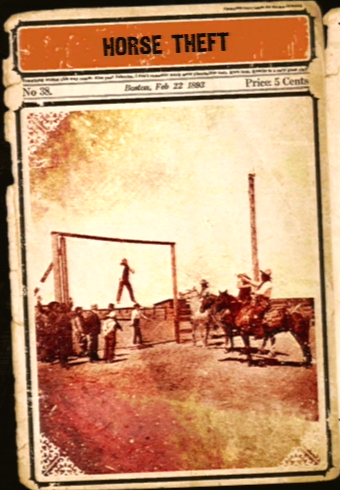 Horse Theft Before the automobile, the horse was the primary means of transport in the Old West and having one often meant the difference between life and death for settlers living in the mountains or the endless prairies of the western United States. Without a horse, there was no way to work the land or herd cattle or get to the mine or fetch a town doctor in time to save whoever had fallen ill or been injured. In fact, without a horse, it was mighty hard to survive at all. No wonder horse thieves were treated as the scum of the Earth and were usually lunched without a trial. A gallows was a common sight in the Wild West and many men met their demise at the end of a rope because they stole an animal that didn't belong to them. TheJayOfSpade fucked around with this message at 15:45 on May 20, 2016 |
|
|
|
TheJayOfSpade posted:Just be kind and if you have a late game story spoiler for something like Red Dead Redemption, just put that in Spoiler Text. Blondie shoots Angel Eyes
|
|
|
|
JordanKai posted:Blondie shoots Angel Eyes The Pale Rider was the murdered sheriff all along
|
|
|
|
citybeatnik posted:The Pale Rider was the murdered sheriff all along He wasn't the man who shot Liberty Valance
|
|
|
|
I've never played these games despite having a soft spot for the Wild West setting. Glad to see you had your priorities in order and understand how important a Nice Hat is. Considering the framing device, if you get a game over does Silas say something in narration like "that's not how it happened" or something similar or is it a standard game over.
|
|
|
|
RydogZeta posted:Considering the framing device, if you get a game over does Silas say something in narration like "that's not how it happened" or something similar or is it a standard game over. A lot of the times there's just a screen saying "You Died" but in Duels he'll usually say something like "Wait, I'm remembering it wrong!"
|
|
|
|
Some fanart from my friend Square
|
|
|
|
 This weeks video is a bonus video discussing the history of one of the Wild West's most famous outlaws: Billy the Kid. Episode Two of the LP will be out next Friday. TheJayOfSpade fucked around with this message at 02:30 on Jun 4, 2016 |
|
|
|
 The Second episode of Call of Juarez: Gunslinger is here!
|
|
|
|
And here are all the new nugs. Careful, they're hot!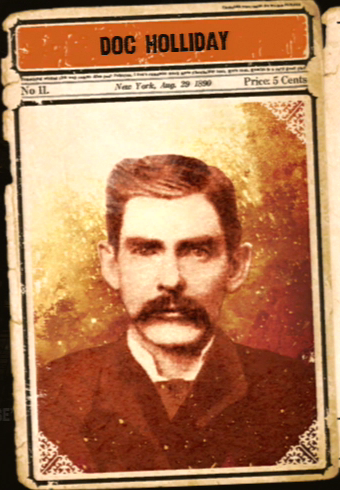 Doc Holliday John Henry Holliday, better known as “Doc” due to his degree in dentistry, was born on August 14, 1851 and died of tuberculosis on November 8, 1887. He is best remembered as Wyatt Earp's friend. The famous sheriff wrote about Holliday in an 1896 article. “Doc was a dentist, not a lawman, or an assassin, whom necessity had made a gambler; a gentleman whom disease had made frontier vagabond; a philosopher whom life had made a caustic wit; a long, lean ash-blond fellow nearly dead with consumption, and at the same time the most skillful gambler and the nerviest, speediest, deadliest man with a six-gun that I ever knew.” Doc Holliday fought in the famous “Gunfight at the OK Corral” at Wyatt's side. He received a flesh wound and, in return, filled Tom and Frank McLaury full of lead, killing at least the former of the two. No one ever expected that Holliday would die in bed with his boot off, least of all him. The tuberculosis that ravaged his body for most of his days finally took hist life. On his deathbad, he asked his nurse for whiskey. When she refused him, he looked down at his bootless feet and uttered his last words: “drat, this is funny.” 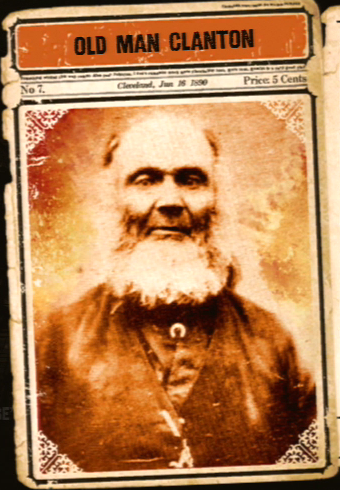 Old Man Clanton Newman Haynes Clanton, also known as “Old Man” Clanton, was born circa 1816 and lived until his violent death on August 13, 1881. It is believed that the “Old Man” was stealing cattle from Mexican rancheros and selling them in the United States. He was the alleged leader of “The Cowboys” a loose gang of outlaws, gunmen, rustlers, and cutthroats. In July of 1879, “The Cowboys”, among them Johnny Ringo, “Curly Bill” Brocius, Frank and Tom McLaury, and Ike and Billy Clanton – led by the Old Man – executed the leader of a squad of Mexican Rurales. The Mexicans had illegally crossed the border in pursuit of the murderers who had robbed a rancho in Sonora, Mexico. Two years later, in July 1881, “The Cowboys” massacred and robbed nineteen Mexican smugglers transporting silver through Skeleton Canyon. Only weeks after that event, the Old Man, with several of his men, were herding stolen cattle through Guadalupe Canyon near the border. At dawn, the Rurales had their revenge. Most of the cowboys accompanying Clanton died that day. Old Man Clanton himself was shot while preparing his breakfast, falling face first into the cooking fire. 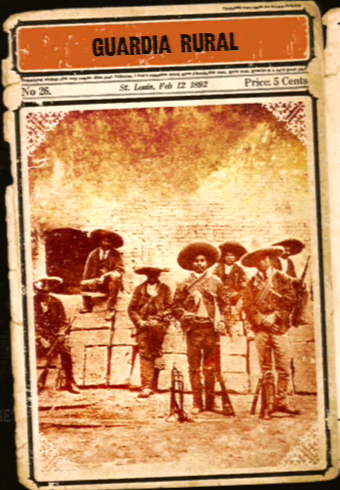 Guardia Rural Guardia Rural, commonly called the Rurales, was a mounted Mexican force tasked with policing bandits on Mexican soil. It existed between 1861 and 1914, and over time grew from a force of a few hundred to four thousand. Heavily armed with sabers, rifles and pistols, wearing characteristic silver-lined uniforms, wide-brimmed sombreros and red or black ties, the Rurales were probably the most flamboyant police force in the world, next to the Vatican guard. On August 13, 1881 in Guadalupe Canyon on the Arizona/New Mexico border, a group of vengeful Rurales (possibly under the command of Captain Alfredo Carrillo who had barely escaped alive from a previous encounter with bandits) surprised Old Man Clanton and six members of his outlaw gang, The Cowboys. Two weeks earlier Clanton and The Cowboys had massacred Mexican smugglers transporting silver across the border. Two years before that incident, the Cowboys had ambushed and murdered a squad of Rurales who had crossed the border into Arizona. At Guadalupe Canyon, Clanton's luck finally ran out. Five Cowboys including the Old Man himself died in the Rurales' ambush. Operating on US territory, the Rurales acted without approval from any local authority. Thus, their act of vengeance on Clanton was no different than what Clanton had perpetrated two years earlier. 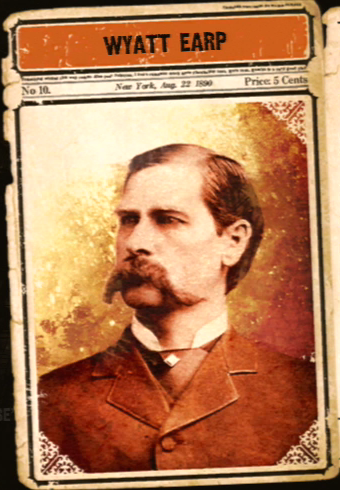 Wyatt Earp Born in Illinois on March 19, 1848, he lived a long and storied life, finally passing away in Los Angeles, California on January 13, 1929. At one time or another he was a farmer, bouncer, saloonkeeper, dealer, prospector, boxing referee, teamster, buffalo hunter, entrepreneur, and – most famously – a sheriff. He is celebrated mainly for his role in the Wild West's most famous shootout: The Gunfight at the OK Corral. That fight lasted all of 30 seconds and those seconds defined him for the rest of his days. That fracas led to what became known as the "Vendetta Ride." Wyatt Еагр, Doc Holliday, and a few other compadres exacted violent revenge on the men they believed responsible for the wounding Virgil Earp and the murder of younger brother, Morgan. The vendetta ended with Wyatt personally shooting the then leader of "The Cowboys," "Curly Bill" Brocius. Or at least that's the legend. Tall for his time, stocky, and clearly fearless, he often dealt with outlaws without ever drawing his revolver. He claims to have never been shot and if that's true that's an amazing feat, considering all the hot lead that flew by him in his lifetime. It's not surprising that he became an icon, sparking the imaginations of countless filmmakers, biographers and writers. His name is instantly recognizable even to those who don't know much about the history of the American West.  Curly Bill Brocius William "Curly Bill" Brocius was born around 1845, and died - probably by Wyatt Earp's hand - on March 24, 1882. He was a saddle tramp, a gunfighter, a rustler, and a member of the outlaw gang known as "The Cowboys." After Old Man Clanton's death, Curly Bill became the informal leader of "The Cowboys". He was described as tall and stocky with a head full of thick curly hair. By all accounts, he was considered an excellent shot. Brocius liked to drink however, and, under the influence of alcohol, his sense of humor could become deadly for those around him. Once, he made a preacher "dance" during a church service by shooting at his feet. On another occasion, he ordered several Mexican peasants to strip naked and dance for his amusement. Apparently, when intoxicated, Brocius enjoyed watching naked people jump at his command. Brocius probably had a hand in the murder of Morgan Earp, Wyatt's younger brother. This was in revenge for the famous Gunfight at the OK Corral and the death of Billy Clanton and the McLaury brothers. Wyatt Earp would avenge Morgan by killing Curly Bill at Iron Springs, in a shootout between Earp’s posse and “The Cowboys”. 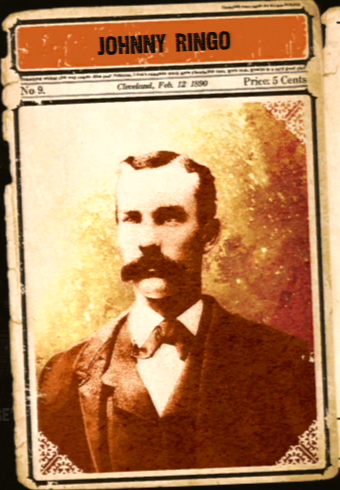 Johnny Ringo John Peters Ringo was born on the May 3, 1850, and ended his life of violence 32 years later. History remembers him as an outlaw and a gunfighter who was associated with "The Cowboys" gang in his final years. In 1874-76, Ringo earned his reputation as a dangerous desperado while fighting in the Mason County War. His deeds during that conflict cost him almost two years in jail before the charges were finally dismissed. Soon after arriving in Arizona, an inebriated Ringo shot and wounded a man in a saloon for preferring to drink his beer instead of the whiskey Ringo bought for him. It is no surprise that around Tombstone, Ringo's reputation was that of an ill-mannered, ill-tempered, violence-prone saddle tramp, especially when drunk. On the other hand, who knows what his reputation would have been if the fight at the OK Corral had gone differently. History is written by the victors and Wyatt Earp and his brothers not only won the actual fight, but the PR battle as well. On the 13th of July 1882, Johnny Ringo was found dead with a gunshot wound in his head and a revolver in his hand. He was sitting under a tree, barefoot. His horse was found two weeks later, his boots tied to the saddle as cowboys often do to keep the scorpions out. His death was officially ruled a suicide, but we still don't know whether the "King of the Cowboys" was killed (by Wyatt Earp or Doc Holliday) or if he simply shot himself because he felt his life was no longer worth living. 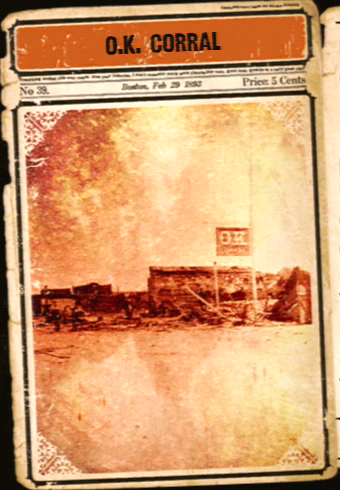 O.K. Corral On October 26, 1881, in Tombstone, a town in the Arizona Territory, an incident known today as the "Gunfight at the O.K. Corral" took place. It was a clash between two warring factions: an outlaw gang known as "The Cowboys" and the lawmen who wanted those criminals to give up their guns. The first group included Ike Clanton and Billy Claiborne, who escaped, unarmed and unharmed. Their companions, brothers Tom and Frank McLaury, did not survive the fight. They [sic] second group consisted of Wyatt, Virgil, and Morgan Earp. They were joined by a hastily sworn in deputy, the notorious gambler and gunslinger, Doc Holliday. An attempt to disarm "The Cowboys" quickly turned into a brief but intense gunfight at close range. Virgil Earp yelled for them to "Throw up your hands, I want your guns!" Frank McLaury and Billy Clanton reached for their revolvers and cocked them, clearly not intending to surrender. Virgil shouted, "Hold! I don't mean that!" Moments later shots were fired and when the smoke had cleared, three Cowboys were dead, riddled with bullets and buckshot. The dead ended up at the local Boot Hill, a name used in the Wild West for graveyards where gunslingers and troublemakers were buried...as they commonly died with their boots on and not in bed like respectable citizens. Before the town of Tombstone was founded, a scout named Ed Schieffelin was looking for ore samples in a very inhospitable area. A friendly soul told him, "The only rock you will find out there will be your own tombstone.” When Ed finally managed to find a valuable silver vein, he couldn’t help but name his mining operation Tombstone.
|
|
|
|
I loving love the way this game is framed, but understand they couldn't very well market it subtitled as "Bullshitter."
|
|
|
|
So we've gone from Young Guns to Tombstone! Fun! I've always been a big fan of Westerns, and tried a few Western-based games. Obviously Red Dead Redemption is the king of this genre, but the Juarez games have been an enjoyable series for the most the most part. I especially enjoyed the Dueling mechanic in Bound in Blood over what they had in RDR.
|
|
|
|
 I put a lot of work into this weeks bonus episode, I hope everyone enjoys!
|
|
|
|
 Happy Friday, I meant to post this in the morning, but work happened!
|
|
|
|
 Vigilance Committees In the Wild West, where the law either didn't exist or was represented by corrupt authorities, groups of citizens called vigilante committees often took the law into their own hands. These citizens acted as judge, juгу, and executioner, often hanging the accused from the closest tree. Their guilt was often anything but assured. Some of these vigilantes became local folk heroes and often gained considerable influence. Such was the case with the Montana Vigilantes, responsible for hanging Henry Plummer and twenty-one other suspects. (Ironically, they accused these men of belonging to a mysterious gang called The Innocents.) The last of those unfortunate souls was hung for merely voicing doubts in regards to the guilt of his friends. What was even more suspicious was that after Plummer and the rest of those suspects were hung, the gold robberies continued unabated. Some say that the Montana Vigilantes were the true bandits. Many of the early stories that pointed the finger of guilt at The Innocents were written by a member of the Vigilantes, the editor of the Montana Post. 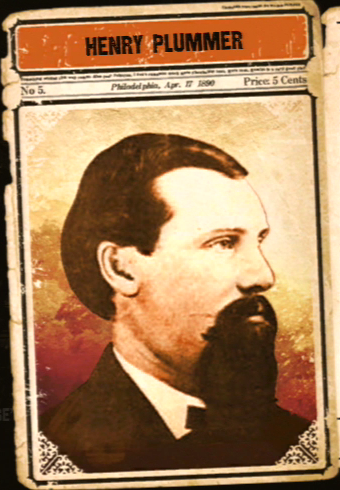 Henry Plummer He was born William Henry Handy Plummer in Addison, Maine in 1832. At the age of 13, he headed west for the gold fields of California. By all accounts, Plummer cut a handsome figure and was quite handy with a Colt. Within two years, he owned a mine, a ranch, and a bakery in Nevada City. In 1856, he was elected Sheriff and City Manager, but that next year Plummer killed John Vedder, the husband of the woman he had been seeing on the side. Sentenced to ten years in San Quentin, the governor subsequently pardoned Plummer as he was suffering from tuberculosis. Plummer's trail eventually led him to the gold fields of Bannack, Montana where he was promptly elected Sherriff. Crime was on the rise in Bannack as a gang of bandits known as the Innocents were attacking miners and hijacking gold shipments. The locals organized a group known as the Vigilantes to go after them, and the leader of the Innocents was discovered to be the Sheriff himself, Henry Plummer. The Vigilantes hung twenty-two men, including the Sheriff, but before they stretched his neck, some say he made them an offer. "Give me two hours and a horse and I will bring back my weight in gold." Could he have said such a thing? Who's to say? Some historians believe that Plummer may have been an innocent victim of the Montana Vigilantes. Some even say the Innocents never existed at all and that the Vigilantes were the actual bandits. We'll probably never know the truth as to whether Plummer was a hero or a killer. 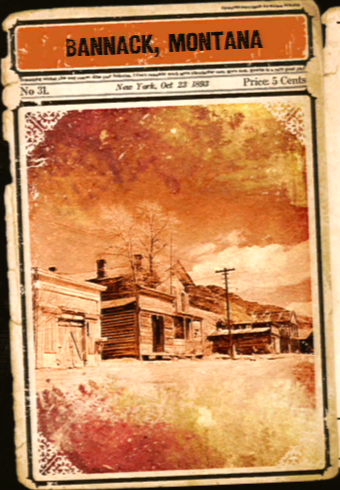 Bannack, Montana Currently, a well-preserved ghost town in Beaver County, it's famous for what happened from 1863 to 1864, when the local sheriff, Henry Plummer, was accused of being the ringleader of a mysterious gang known as "The Innocents". Some believe they were responsible for nearly one hundred murders. A citizen's group known as the "Montana Vigilantes" summarily hanged 22 people for those crimes, including Henry Plummer himself. Bannack, founded in 1862, was named after the native Bannock tribe. In 1864, it briefly served as the capital city of the Montana Territory. It remained a mining town until it was deserted by its last residents in 1970. During its prime, Bannack boasted a population of over ten thousand residents. There were three hotels, three bakeries, three smithies, two stables, two meat markets, a grocery store, a restaurant, a brewery, a billiard hall, and four saloons. 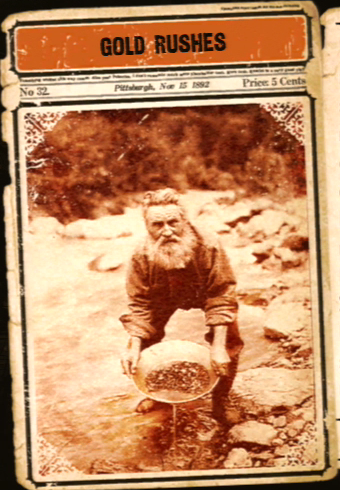 Gold Rushes Gold rushes, typical of the nineteenth century, were large scale, sudden migrations to often remote locations where gold-bearing deposits were discovered. The largest and most famous was the California gold rush of 1848. John W. Marshall found a gold nugget at John Sutter's sawmill in Coloma, California. News of the discovery spread quickly and people flocked to California from all over the world for a chance to get rich quick. Logging camps and military forts emptied out. Sailors jumped ship. Farms and businesses were abandoned. Over 300,000 people came to California. These "Forty-Niners" traveled west overland on the California and Gila River trail or by sea around Cape Horn at the far southern tip of South America. Most who made their fortune did not discover gold, but preyed upon those who came west hoping to strike it rich. The history of the Wild West is rife with similar gold rushes. One of the largest was The Pike's Peak Gold Rush. An estimated 100,000 prospectors flooded into the Rocky Mountains between 1858 and 1861, when the Colorado Territory was established. Another famous example was The Black Hills Gold Rush of the late 1870s. Thousands of prospectors followed the Custer Expedition deep into Indian Territory. The city of Deadwood, South Dakota was established nearby and to this day is a busy tourist town, complete with saloons and casinos. It is famous for the fact that one of the frontier's greatest gunslingers, Wild Bill Hickok, died there in a saloon, shot in the back of the head while playing poker. 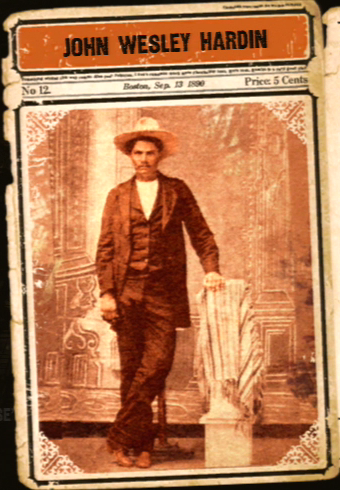 John Wesley Hardin Hardin, born on May 26, 1853, was one of the West's most notorious killers. Next to Wild Bill Hickok, many considered him to be the fastest and most accurate gunslinger who ever lived, or at least the deadliest, as he is believed to have killed 41 men in various duels, shootouts, and other sundry incidents. One story has him shooting a man for snoring too loudly, but many believe that is simply a fanciful legend. Some considered him a cold-blooded killer, while others thought of him as a folk hero. He had a price on his head from the age of fifteen, but Hardin allegedly only killed in self-defense or to defend his freedom. Finally arrested by the Texas Rangers, Hardin spent many years in prison, where he frequented the prison library and taught himself the law. He was sentenced to 25 years, but released after only 17 and promptly passed the bar exam. He tried to make a living as a lawyer, but proved to be a much better gambler. Hardin could usually be found sitting in a saloon, playing dice or cards. It is an irony that one of the most deadly gunfighters who ever lived met his end the same way his idol, Wild Bill Hickok, did. Both were shot in the back of the head while gambling. Hickok was murdered by Jack McCall and Hardin by John Selman on August 19, 1895. 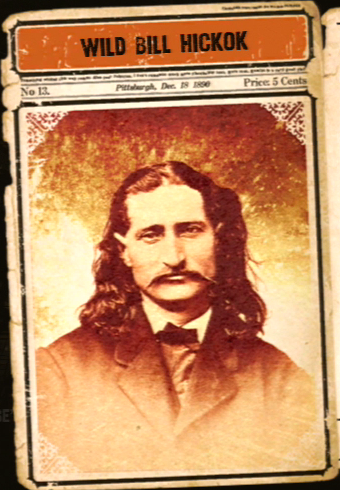 Wild Bill Hickok James Butler Hickok, also known as Wild Bill, is considered by some to be the most famous western gunslinger of all time. He is remembered as a tall, slender man with long flowing hair and an omnipresent pair of holstered Colt 1851 Navy cap and ball revolvers. Born in Troy Grove, Illinois, in 1837, he worked as a stagecoach driver, fought for the Union army during the war and later became a scout, a lawman, an unlucky professional gambler, and a not very good actor, who trod the boards with Buffalo Bill until he realized that the theatre wasn't his true calling. What he did best was put outlaws, killers, ornery assholes, and drunk cowboys in their graves by filling them full of lead. The high noon showdown in the middle of the street, a staple of Hollywood Westerns, was not a very common occurrence. As a matter of fact, they hardly ever happened... unless Wild Bill happened to be in town. If anyone was willing to stand in the street at high noon and face someone down that would be William Butler Hickok. In 1876, Hickok was diagnosed by a doctor in Kansas City with trachoma, an inflammation of the eye. He was losing his ability to see and so his marksmanship and health were on the wane. As his finances were in trouble, he set out for Deadwood, South Dakota where a recent gold strike had created a boomtown full of drunken miners; a perfect place for a professional gambler to ply his trade. On August 2nd of that year, while playing poker in the "Nutall & Mann's No. 10" saloon, Bill broke a rule he'd been following for years, perhaps for the first time ever. He sat with his back to the door. A former buffalo hunter named Jack McCall entered the saloon at that very moment and drew his revolver shouting, "drat you! Take that!" and shot Bill on the spot. The bullet went right through the gunslinger's head and hit another player at the table in the wrist. Legend has it that at the moment of his death Wild Bill was holding a pair of aces and a pair of eights, all of them black. Since then that hand is commonly referred to as the dead man's hand. 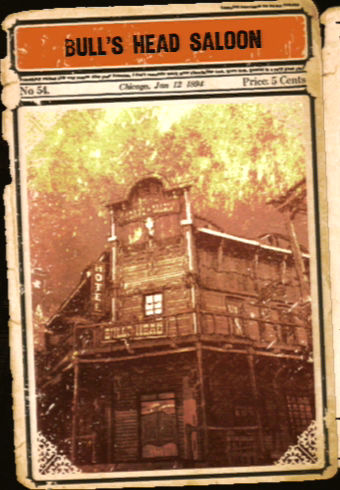 Bull's Head Saloon When Phil Coe opened the Bull's Head in Abilene, Kansas, he enraged the local townsfolk by painting a picture of a bull on the side of his saloon. This particular bull had a large erect penis. The law in Abilene at the time was none other than 'Wild' Bill Hickok. He threatened to torch the building if the obscene painting was not removed promptly. Before Coe could make up his mind, Hickok paid a few men to paint over the bull and its offending private part. This infuriated Coe and he confronted Wild Bill. Coe clearly disliked Hickok and this animosity grew until one day Coe fired two shots at the marshal and missed. Hickok returned fire, cutting Coe down. He also accidentally killed his own deputy, Mike Williams, who was coming to his aid. Williams' death haunted Hickok until the very end of his life. 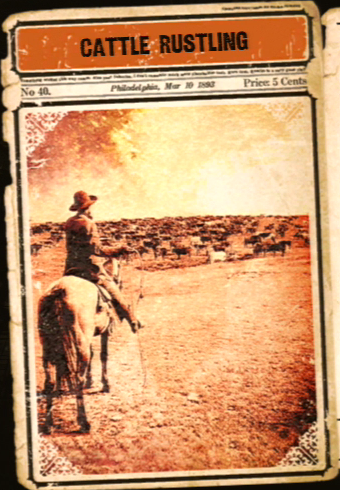 Cattle Rustling Before barbed wire was used to divide the free ranges of the Wild West, cattle rustling had thrived. Many famous outlaws of the time like Billy the Kid, the Clantons, Curly Bill, and Johnny Ringo all tried their hand at stealing cattle. It was obviously considered a serious offense and punished accordingly. More often than not, a cattle thief never had a chance to appear in court because a vigilante group would usually lynch the criminal on the spot. Those unlucky desperados hung as grim decorations, dangling solemnly from the branches of roadside trees. It's not surprising considering the fact that cattle were the primary commodity of the West. It was often easier to get away with murder than with stealing a cow. 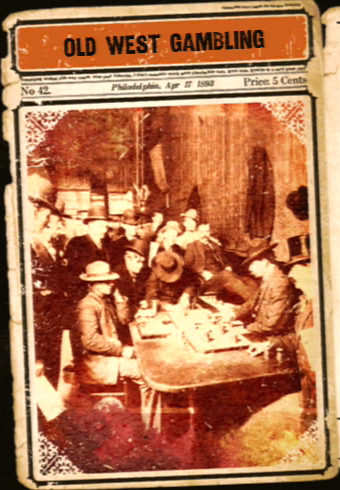 Old West Gambling The Old West was populated with all sorts of adventurers, fortune seekers, thieves, gamblers, and gold diggers. Where there was gold or - in the absence of the noblest element – at least a dollar or two, there were opportunities to spend it. Neither corn whiskey nor saloon girls were free. Saloon owners, however, did offer a third form of entertainment. One that, in theory at least, offered the customer a chance to actually make money, gambling. Poker, dice, and faro, beloved by all, reigned supreme. Where gambling appeared, accusations of cheating usually followed. Let's face it; it was probably a common occurrence. The trick was to do it without getting caught. Plan B was to be so intimidating, no one would dare call you on your seemingly miraculous hand. Naturally, confidence alone wasn't enough. Lightning reflexes and the ability to shoot straight was necessary as well. That's why many famous gamblers were also skilled gunslingers. Celebrities of the West like Doc Holliday, Wes Hardin, and Wild Bill Hickok all fit that description to a T. 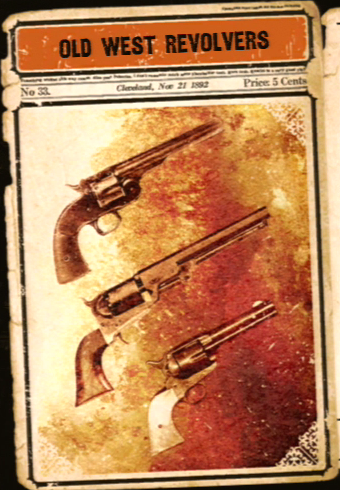 Old West Revolvers Next to the cowboy hat, the object most often associated with the Wild West is the percussion cap revolver, invented by Samuel Colt in 1836. This revolver, along with the Winchester repeating rifle, was the preferred method for dealing death in the latter part of the nineteenth century. The first revolvers were front loading models. Black gunpowder was inserted into the chambers of the cylinder and then covered with a lead bullet. Rammers were used to keep everything in place. All that was left was to place percussion caps on the opposite end of the cylinder. Because of that, the early revolvers were known as caplocks, with the cap and the ball inserted separately. The Colt Patterson and its later incarnations were examples of that design philosophy. This includes the Walker, the Dragoon, the 1851 Navy (Wild Bill Hickok used a pair), the Model 1860 Army and others. The Remington Model 1858 was a unique design because it allowed for the replacement of empty cylinders for loaded ones in the midst of a fight. Later models used integrated cartridges as ammunition, eliminating the need to load each component separately. The Smith & Wesson Model 3 was such a design (one of its variants is known as the Schofield Revolver) and so were Colt's more advanced products. Revolvers also evolved from single-action (where the cylinder had to be rotated by manually cocking the gun) into so-called double-action, where the trigger mechanism would also cock the gun and turn the cylinder with a single motion. One thing remained unchanged throughout the history of the Wild West, in the hands of a skilled gunman, revolvers were deadly weapons.
|
|
|
|
I appreciate that it's really starting to play with the storytelling aspect with that mine bit and a bit earlier with the ambush. I just appreciate the game changing itself for the sake of its narrative. I would hope the game plays a lot more with that but would also understand if it were a less frequent feature.
|
|
|
|
Bonus Episode Friday
|
|
|
|
 Are you ready for more Juarez!?
|
|
|
|
 Native American Heroes Spotted Elk, also known as Big Foot (Sithanka), was a Miniconjou Lakota Sioux chief who bravely fought the White aggressors. He died, like many of his brothers, on December 29, 1890 in the so-called "battle" known today as the Wounded Knee Massacre. Cochise of the Chiricahua Apaches, known among his people as A-da-tli-chi, was a war chief who led a long campaign against the United States Army. He evaded capture many times and continued raids against white settlements until 1872. A treaty was negotiated by General Oliver O. Howard and Cochise ended up on a reservation run by his only white friend, Tom Jeffords. He died in 1874 of natural causes and his descendants are said to currently reside at the Mescalero Apache Reservation in New Mexico. Goyathlay was Cochise's successor in a way. Known better as Geronimo, he won numerous victories over long years of fighting. Mexican soldiers killed his mother, wife, and three children in 1858. He vowed revenge, and as a war chief he constantly raided Mexican provinces and their towns and later American settlements across Arizona, New Mexico, and Western Texas. He surrendered to U.S. authorities in 1886 and became somewhat of a celebrity, even appearing in Wild West shows. But he was never able to return to the land of his birth. He died of pneumonia in 1909 and confessed to his nephew that he regretted his decision to surrender, saying, "I should have fought until I was the last man alive." Sitting Bull, or Tatanka lyotake, the victor of Little Bighorn and later a performer in Buffalo Bill's Wild West show, was a Hunkpapa Lakota Sioux holy man who led his people against the encroachment of the white man. He was killed by two Indian policemen in the service of the United States government during an attempt to arrest him and prevent him from supporting the Ghost Dance movement. Those and many other Native Americans were forced to live in an impossible world. Their lands and way of life were stolen and replaced with a world they didn't understand or want any part of. They were murdered both by bullets and blankets infected with small pox. They died from disease and starvation and exposure as they were shunted onto reservations. Today we recognize the destruction of the Native Americans and their culture as the genocide that it was. Fortunately, history has not forgotten them and now we can celebrate them as perhaps the only authentic heroes of the American West. 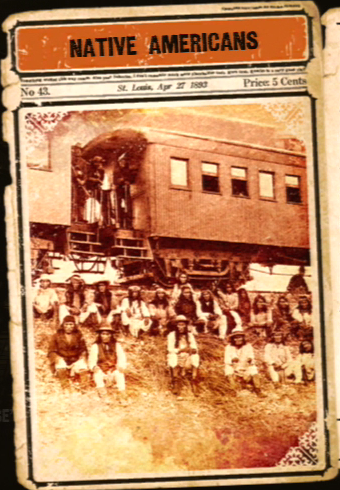 Native Americans Native Americans are the indigenous people of North America. They are composed of numerous, distinct Native American tribes, some of which survive to this day as cultural and political entities. According to the accepted theory, migrations of humans from Eurasia to the Americas took place approximately 12,000 years ago via the Bering Land Bridge. Many of these tribes were decimated during the 18th and 19th century as they were pushed out of their homelands by waves of settlers of European origin. As Native Americans were divided into many tribes, some of which were long-standing enemies, they were unable to unite against a common enemy, invaders armed with advanced technology. L. Frank Baum, the author of the Wizard of Oz, was among the champions of the complete eradication of the remaining Native Americans. He wrote: “(...) The Whites, by law of conquest, by justice of civilization, are masters of the American continent, and the best safety of the frontier settlements will be secured by the total annihilation of the few remaining Indians (...)". Mere days after the Wounded Knee Massacre, called a ‘battle’ at the time despite being nothing more than a bloodbath inflicted by American soldiers on unarmed men, women and children, L. Frank Baum spoke once again, criticizing the government for not taking even more drastic measures, demanding to “(...) wipe these untamed and untamable creatures from the face of the earth." Just like the ancient Celts conquered by Romans, Native Americans left an invaluable and rich legacy evident in the language, philosophy, and popular culture of modern day America. 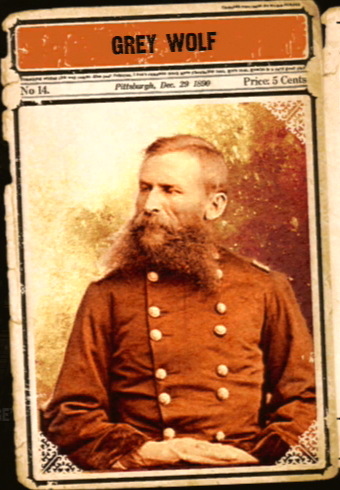 Grey Wolf As it happens, history does not know any great Indian leaders bearing the name Grey Wolf. There was one chief with that name, but he was also an officer in the United States Army. George Crook made his name serving during the Civil War and the Indian Wars. He fought against the Paiute, the Sioux and the Apaches led by Geronimo. The latter, as a token of respect for Crook, nicknamed him Nantan Lupan, which means Grey Wolf. Crook was outraged at the imprisonment of the Chiricahua Apaches who served the American Army faithfully only to be incarcerated alongside Geronimo's rebels. Crook made numerous appeals to Washington but, as was to be expected from the US Government at the time, they had no effect. 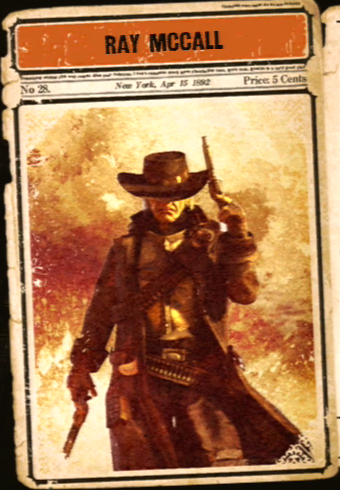 Ray McCall The oldest of the McCall brothers, he and his brothers were sons of a Georgia landowner who fought for the Confederacy in the Civil War. His father died at Antietam and he and his brothers continued the fight. During the battle for Atlanta, he was demoted for insubordination. After the war, he made himself a name as a gunfighter, famous for his ferocity and the antique Conquistador's cuirass he wore as a breastplate. He killed many men to make that reputation and is most well-known for his feud with the infamous Juan "Juarez" Mendoza. Mendoza had an alcazar outside of Juarez, Mexico and ran an army of bandits that terrorized the border for years. After years of working as a hired gun, drifting from town to town, Ray McCall found his calling and became a pastor, leaving his violent life behind. However, his destiny was not to be one of peace, as he picked up his pistols again late in life to hunt down his nephew, suspected of killing his brother and wife. He died in 1884, killed by the same "Juarez" Mendoza with whom he crossed paths with years before. His only consolation was the knowledge Mendoza would surely follow him to the gates of Hell. Surprisingly, the history books are silent on the subject of this extraordinary man, the gunslinging preacher, Ray McCall.
|
|
|
|
It's cool that the color commentary from the bargoers is starting to call our main man out for his fantastical stories but he just keeps on trucking. It's a fun way to tell these crazy dramatized stories but still have fun with its sense of realism.
|
|
|
|
I love the fact that this game has an old time-y western equivalent of the suicide runners from Serious Sam.
|
|
|
|
ChorpSaway posted:It's cool that the color commentary from the bargoers is starting to call our main man out for his fantastical stories but he just keeps on trucking. It's a fun way to tell these crazy dramatized stories but still have fun with its sense of realism. Wait for the next couple of missions. poo poo gets crazy, in a good way.
|
|
|
|
 Juarez is back, baby!
|
|
|
|
 The Daltons Related to the famous Youngers, the Dalton brothers: Gratton, Bob, and Emmett, gave up their jobs as lawmen in the 1890s to form the so-called Dalton Gang. The sole purpose of their enterprise was to rob trains and banks and make a hell of a lot more money than they ever did as peace officers. They also coveted a bit of the notoriety their more famous cousins enjoyed as members of the James Gang. One such robbery ended with the arrest of Grat who then managed to astonish the marshals who had him in custody by escaping from a moving train. Grat stole a key to his chains from a napping guard then jumped through the window right into a river while the train was passing over a bridge. The Daltons weren't always so lucky. One of them, Bob, desperate to make a reputation as an outlaw that would surpass that of Jesse James, suggested an incredibly daring plan. He wanted to rob two banks at the same time, in broad daylight. On October 5, 1892, the brothers rode into Coffeyville, their hometown. They hid behind fake beards and attempted to do what no outlaw had done before. Their bold plan ended in complete disaster for the brothers and their comrades in arms. Bob died that day and his brother Emmett, shot twenty-three times, miraculously lived, went to prison, and was later pardoned. He died in Hollywood in 1937, after trying his hand at being an actor, an author, and a real estate agent.  Coffeyville On October 5, 1892, the Dalton Gang appeared in their hometown of Coffeyville, Kansas. Their plan was to rob two banks at the same time. Their targets were C.M. Condon & Company's Bank and First National Bank, located across the street from one another. Brothers Bob, Grat, and Emmett, and their compadres, Dick Broadwell and Bill Power, split into two groups. Wearing false beards, they showed up at both banks when they opened, planning to pull off a quick double heist. One of the groups robbed their bank without incident, but the other was outfoxed by a brave bank employee who convinced the bandits that the safe was protected with a time lock, which wouldn't open for another ten minutes. They waited for it to open and in that time the entire town rallied against them. The citizens of Coffeyville recognized the brothers in spite of their less than clever disguises and had no intention of letting them escape with the money. A bloody gunfight broke out in the streets of Coffeyville and the entire gang was killed, except for the youngest Dalton, Emmett, who was shot twenty-three times. He was sentenced to life in prison, but was released after 14 years. He would often say it was a U.S. Marshall, Heck Thomas, who pushed the Daltons into attempting that crazy plan by tracking them so relentlessly. The Coffeyville robbery was supposed to be the gang's ticket out of a life of crime, instead it was a ticket to the cemetery for most of them.  Dime Novels The term originated with the first book in the Beadle and Adams Dime Novel series, "Malaeska, the Indian Wise of the White Hunter", by Ann S. Stephens, dated June 9, 1860. The series ran for 321 issues and established all the conventions of the genre. From the lurid woodblock print covers to the melodramatic and sensational stories, they were popular among young, working-class audiences, mostly owing to the increased literacy rate of society in general at the time. They told all sorts of outlandish tales, usually in a Western setting. Their style was simple and accessible, the characters were one-dimensional, but they were page turners and a forerunner of modern day mass-printed paperbacks and comic books. They turned many real characters of the day, outlaws and lawmen alike, into celebrities of sorts. They helped create the modern romanticized mythology of the Wild West that continues on in Hollywood westerns and TV shows to this very day.  Black Bart Charles Earl Bowles, better known as Black Bart, was undoubtedly among the Wild West's most unusual stagecoach robbers. British by birth, Black Bart was a polite man, known for his manners and refined taste. It is difficult to believe that such a gentleman-bandit really operated in California and Oregon in the 1870s and '80s. Legend has it that on at least two occasions he left handwritten poems at the scene of the crime. This one is from 1877. I've labored long and hard for bread, For honor, and for riches, But on my corns too long you've tread, You fine-haired sons of bitches. [Addition: the second verse was left at a stagecoach robbery in 1878: Here I lay me down to sleep To wait the coming morrow, Perhaps success, perhaps defeat, And everlasting sorrow. Let come what will, I'll try it on, My condition can't be worse; And if there's money in that box 'Tis munny in my purse. ] Black Bart never lacked personal charm. After getting out of jail, he was asked by a journalist about returning to his criminal ways. He answered with a smile, "No, gentlemen, I'm through with crime." Then another reporter wanted to know if he would write any more poems. Black Bart laughed and replied, "Now, didn't you hear me say that I am through with crime?" He never fired a gun during any of his robberies and all of them were done with him getting to the crime scene on foot due to his deeply held fear of horses. 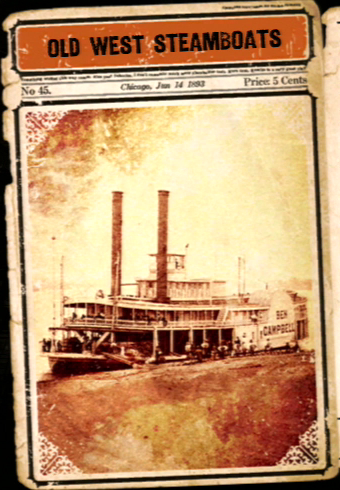 Old West Steamboats While the founding fathers of the United States were writing the Declaration of Independence in 1776, over in France the first successful steamboat was completed. In the United States, the First steam-powered boat was built by John Fitch in 1787. By the first half of the 19th century, American rivers were teaming with steam ships. It was a blessing for the economy. River transport was much faster and cheaper than any kind of land transportation. Numerous ports and shipyards appeared. The ships themselves needed maintenance and dock workers and all that meant new jobs. Of course, early steamboats were far from perfect. Many sunk for any number of reasons. Boiler explosions and fires were common causes of accidents. Between 1811 and 1899, 567 steamboats were lost in the United States. Despite that, people were eager to use this new means of transportation. There were even the enormous "palace steamers" built to ferry passengers and cargo across the North American Great Lakes in the mid-19th century. The Titanic was the largest steamship in the world when it sank and remains history's most famous and decidedly unlucky steam powered ship. In the second half of the 20th century, steamers were almost completely replaced by diesel-powered ships. 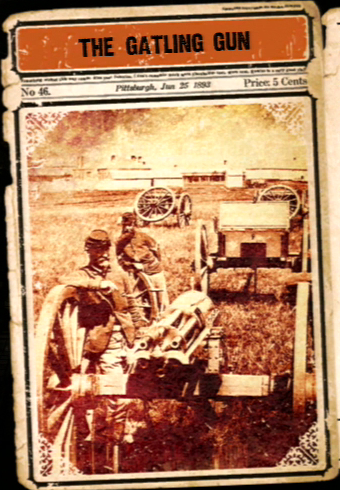 The Gatling Gun Built by Richard Gatling in 1861 and first deployed in combat during the Civil War, the multi-barreled Gatling gun was one of the precursors of the modern machine gun. But unlike modern machine guns, it was not fired automatically, but rather operated by a gunner who had to crank it. During each turn of a hand crank, each barrel fired a single shot, after which it ejected the spent cartridge, loaded a new round, and in the process, cooled down. This allowed for a higher rate of fire without the barrel overheating. The Gatling Gun offered an unheard of high rate of fire and was relatively easy to reload. In the right hands, they were a devastating weapon. Gatling guns were finally replaced by the self-powered Maxim machine guns that used recoil energy to eject spent cartridges and insert fresh ones. In its prime, however, the Gatling Gun was a fearsome weapon. [Addition: On the Maxim gun, in the words of Hilaire Belloc’s “Captain William Blood”, in the 1898 The Modern Traveller, a satire on colonialism: 'Whatever happens, we have got The Maxim Gun, and they have not.' ]
|
|
|
|
I've always found it really interesting how stylish this game is. I've never played them, but I've always heard the other Call of Juarez games are pretty much mostly just bog-standard shooters. This game just nails the effects, the writing, and it came out at a discount price, IIRC? Basically Gunslinger is good as hell and I'd recommend it pretty highly. Love the LP so far.
|
|
|
|
 A day late and a few dollars short after playing this great arcade game!
|
|
|
|
 Do you believe in ghosts?
|
|
|
|
I'm not going to be making anymore extras, I just want to focus on finishing this LP.
|
|
|
|

|
|
|
|
Oh shoot, almost missed this! Glad to see it back, I really like the writing in this game and I enjoy the light commentary to make sure the game's dialogue stands out. I mean you're very funny and handsome but I'm glad you let the game speak for itself sometimes. Miku LP when
|
|
|
|
This game uses its frame story to get in a lot of neat little gags, but the repeating train car while Silas takes a pee might be my favorite.
|
|
|
|

|
|
|
|

|
|
|
|
Great lp Jay. It convinced me to buy the game.
|
|
|
|
It goes on sale quite often. Deff-o worth picking up at $3.75
|
|
|
|

|
| # ? Apr 26, 2024 01:01 |
|
TheJayOfSpade posted:It goes on sale quite often. Deff-o worth picking up at $3.75 That's what I got it for. And no Uplay, which a lot of people hate for some reason.
|
|
|


